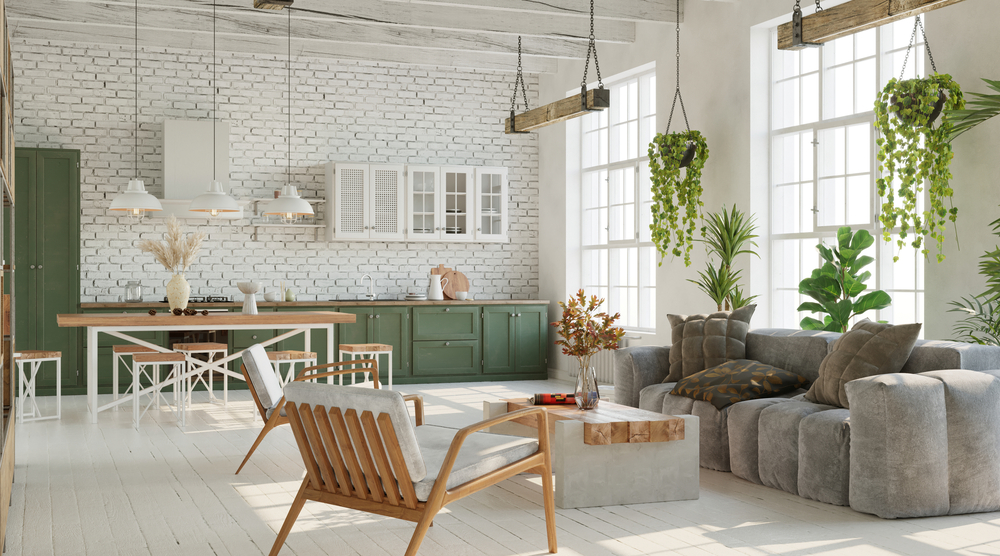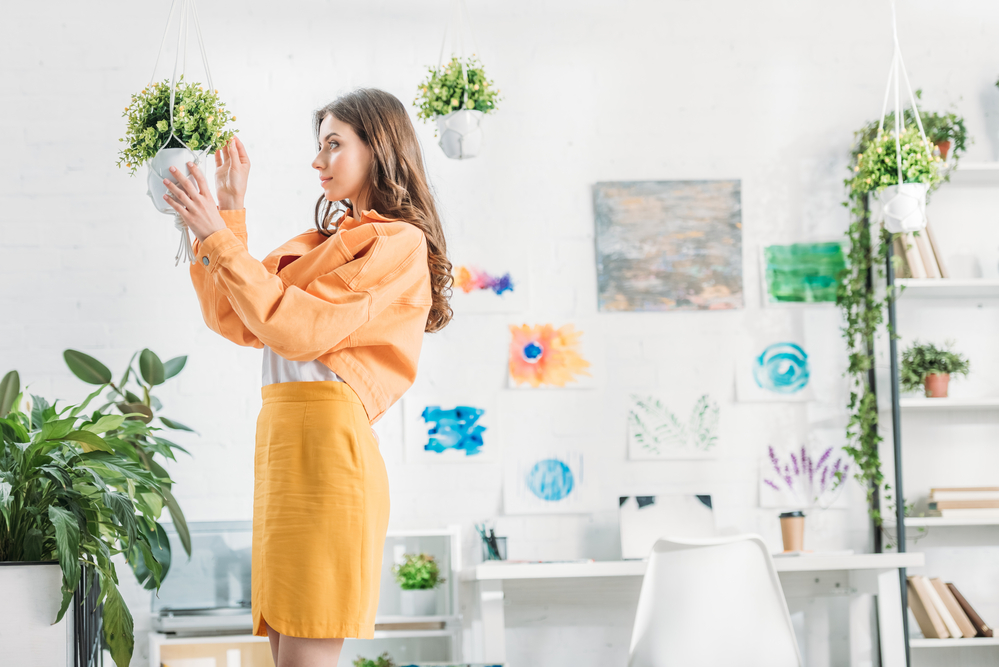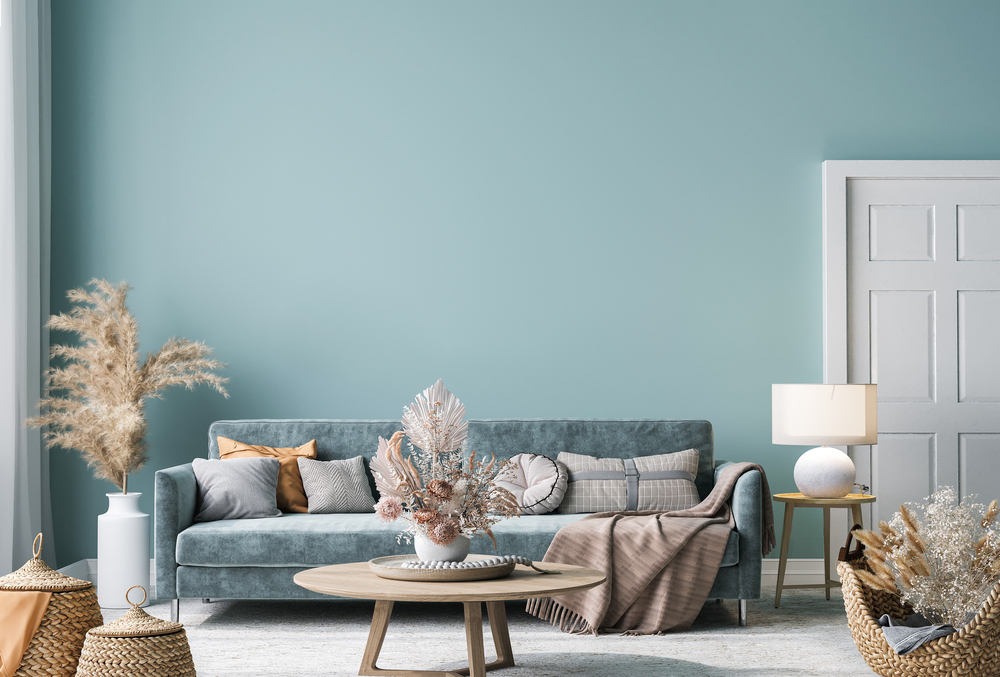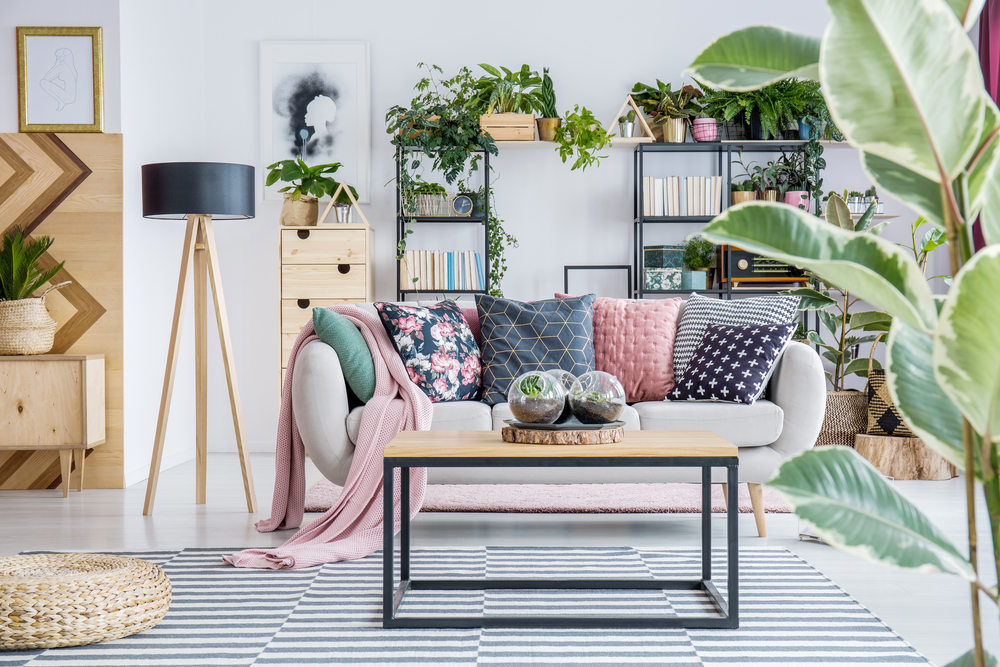
The trend towards interior design aesthetics that complement the natural world is not going away any time soon. We see it in colors, in materials and in overarching interior decor styles like modern farmhouse. That is well and good with homes of a certain size and design, but modern farmhouse is not going to work in every home.
Yet living in a city apartment, or perhaps a town house, need not prevent you from adopting other methods to achieve a natural look. There is no better way than by bringing a sense of the outside in through the use of plants and greenery. Not only does it look good, it can also elevate the atmosphere in your living room by improving air quality. That benefits every member of the family, so let’s find out more.

Think vertical in smaller spaces
If space is at a premium in your living room, you won’t be able to accommodate expansive planters. Making optimum use of the space available demands some lateral – or more specifically, vertical – thinking.
Macrame is the art of rope weaving, and it has never been more popular. A macrame plant hanger retains that natural theme and you can create something that is completely unique. Also, the benefit of macrame being so on-trend is there are plenty of options depending on just how creative you feel.
By all means, take a “first principles” approach with a reel of rope if you wish. However, you can also buy kits from the usual online platforms that contain everything you need and take you through each step. Macrame doesn’t just mean “nautical”. Try experimenting with a flash of color here and there to give your hangers a fun vibe.

There’s more to plant life than blooms
Flowering blooms are gorgeous and are a welcome addition to any living room. But when considering how to incorporate plant life into your living room, think of them as finishing touches, like the earrings that might accessorize a beautiful dress.
Overdo it on the blooms and for one thing, your living room will look like a florist’s, for a second, people will think it is your birthday every day and for a third, you will be removing and replacing every few hours.
We will look at some feature plants in just a moment that are all about the leaf. But also, consider designing with branches, fronds, stems and sticks. These will add a natural sense of rustic simplicity. Best of all, they are easy to work with and they will last indefinitely.
Vines can also give a truly unique look if left to grow. Don’t obsess about neatness and uniformity. Simply give them a little guidance on where to go, and let them style your living room furniture in their own unique way. Varieties like ivy and creeping fig can wind themselves up the legs of occasional tables or even across the TV console – just ensure they stay out of the TV itself! Also, note that these, along with other creeping vines like philodendron and pathos can be toxic to cats and dogs.
Try a feature piece
Modern living rooms tend to lack a focal point. 50 years ago, it was the fireplace and 20 years ago it was the TV. Today, we don’t necessarily have a TV in the living room and if we do, it might be disguised or concealed when out of use.
Most interior designers will tell you that a living room needs a focal point and that without one, the room will lack coherence. A large, bold plant in a prominent position fits the bill to perfection. Consider the following options:
- Fiddle leaf fig – this is to plant enthusiasts as Labradoodles are to dog lovers – everyone seems to want one at the moment! The fiddle-leaf fig tree has a lot going for it. It’s fast-growing, relatively easy to take care of and grows to a height of six to ten feet. Note, however, that it is toxic to cats and dogs, so if you do have one of those Labradoodles, you might want to consider an alternative plant.
- Areca Palm – also known as the butterfly palm, this plant is safe for house pets. Just be aware that it needs plenty of light and warmth to thrive. In the right conditions, it produces beautiful and expansive fronds – it certainly won’t let you down as a focal point!
- Strelitzia Nicolai – often called the White Bird of Paradise, this tropical plant looks as exotic as it sounds. The gigantic glossy leaves conjure images of a tropical rainforest. You might read online that the plants can grow to 20 feet in height – don’t let that put you off, as when grown indoors, they are unlikely to grow beyond eight feet as a maximum.
- Monstera deliciosa – the Swiss Cheese Plant does not grow to the sizes of some of the plants mentioned above, but it still has the presence and wow factor to form an effective focal point for any living room. It prefers indirect sunshine so does not have to be by a window, but will benefit from a few days out in the sun during the summer months to encourage growth.

Anyone can grow succulents
Not everyone is experienced in looking after plants. In fact, there are many who claim to have the opposite of a green thumb or what English author Douglas Adams called “Lutton Gowts” – “the effortless propensity to cause plant death.” If that strikes a chord, and you are concerned that purchasing a houseplant is tantamount to giving it a death sentence, then succulents could be the perfect choice.
Even if you are comfortable in your ability to take care of plants, you might spend more time away than home, and feel unable to devote the time and care that some plants need. Succulents require only minimal attention, and they are remarkably tolerant of being neglected for days on end, as they only need occasional water and maintenance.
Succulents are generally small and are characterized by linear shapes. They work well to accentuate a more modern, contemporary style of decor, and are, again, well worth considering when you have less space at your disposal.
As well as the vertical themes we touched on earlier, you could even have one or more succulents as a tabletop terrarium – a more modest kind of a centerpiece, perhaps, but one that is no less stylish and eye-catching.
Harness the power of technology
Regardless of how green your thumb might be, technology is always on hand to assist with taking care of your plants. There are all sorts of gadgets on the market, from water sensors to smart plant pots. The great thing about the latter is that they look elegant yet contemporary. In other words they won’t stick out like a sore thumb and can actually be interesting accessories and conversation pieces.
In case you’ve not encountered one before, a smart plant pot uses IoT sensors to monitor your plant and can even add water in just the right amounts, when needed. You can even get smart pots that bestow your plants with emoticions to more effectively tell you their needs. A silly gimmick? Of course it is, but it’s also a great way of encouraging the younger members of the family to get involved in plant care!
Bringing it together
Perfecting the look that you had in mind is always a challenge, and it’s not one that is restricted to the use of plants and greenery. Bringing everything together takes a delicate touch. It’s all too easy to feel as if you have walked into a furniture showroom set, not a real home. Typically, there’s a simple reason behind it – over-enthusiasm on the part of the interior designer.
It’s extra important when using living plants as the core of your living room decor to adopt a “less is more” approach. Give each plant, from the mighty bird of paradise to the smallest cactus, room to stand out for itself.
Avoid these elephant traps
Whatever Douglas Adams might have claimed, anyone can take care of a houseplant or two. If you are consistently finding that they either die on you or they look sickly and show little appetite for growth, it is almost certain to be down to one of the following:
Insufficient light
It might be a few years since you learned about photosynthesis at school. In short, plants need light in order to convert oxygen and water into carbohydrates and thereby to bloom and to thrive. Not every living room has a huge south-facing picture window, and sometimes it is a case of making the best use of what you have got. Clever positioning of a wall mirror, for example, can work wonders, and the human occupants will get a boost of Vitamin D and serotonin, too. You can also supplement natural with artificial alternatives. LED lights are small, unobtrusive, cheap to run and easy to fit. They can also be angled and directed to give low-light plants the little boost that can make all the difference.
Lack of root care
“Out of sight, out of mind” is a philosophy that can lead to disaster when it comes to plant roots. In particular, when the roots start to outgrow the pot, the plant will be unable to take in the nutrients it needs and inevitably, its health will suffer. You should check the roots at least three times per year, and as often as monthly for a fast-growing plant. If you catch root problems early, it is a simple matter to remove the dead root tips while re-potting your plant into a larger pot. Left unattended, however, dead roots can ultimately be catastrophic.
Too much change
We light heartedly compared a plant to a pet dog earlier. The truth is they have even less in common than the immediately obvious. Specifically, while your four-legged friend would prefer never to leave your side, plants naturally spend their lives in the same spot. Yes, there will be times you have to move them around, whether it is for repotting or to give something like a Swiss cheese plant a day or two out in the sunshine, but for the most part, try to avoid moving plants around. Sometimes “do nothing” is the best course of action.
Lack of understanding
If you don’t know what you’ve got or from whence it came, all hopes of it thriving are trusted to chance. Tropical like moist soil and humid conditions. We mentioned earlier that cacti are difficult things to kill, but they will only really thrive in dry soil mixed with a little sand. You don’t have to become a walking encyclopedia on house plants, but just sparing 15 minutes to acquaint yourself with the basics about your plants, whatever type they are, will be time well spent that will pay you back a hundredfold in the years ahead.

Make the most of a unique look
Decorating your living room with plants and greenery is not an exact science. There is no right or wrong to it, but some of the above points are worth keeping in mind, especially if you are inexperienced in taking care of houseplants. They will also give you food for thought on what to consider, or indeed to avoid, if you have pets or small children in the equation.
Ultimately, as with any interior design decision, your living room decor need to provide a warm and atmosphere that reflects the personalities of those who spend their time living in it. Focus on making sure the space makes sense to you and you can’t go far wrong, regardless of the style of your home and the size of your living room.

